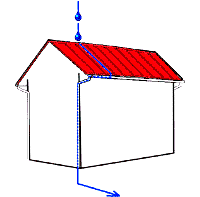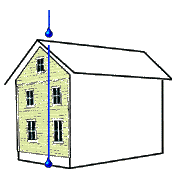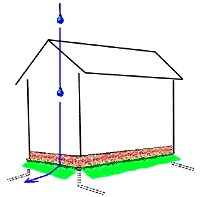How Your House is Connected
The Roof/Gutter System. Imagine a drop of rain landing on the ridge of the roof, then rolling down and across the shingles. The shingles should span the entire roof like a skull-cap, with no interruptions, such as breaks, holes, or missing pieces. Then, if the house has an overhanging eave or projecting cornice, water is further directed away from the wall below.
Roof/Gutter SystemAs the rain continues, it may rush down the valley of the roof with some intensity. To protect the historic building materials at connecting points, the valley is flashed with copper or sheet metal. This valley flashing is also part of the roofing system.
Gutters are usually attached to the eaves or built into the cornice, sometimes forming part of the decorative scheme.
At the edge of the roof, gutters capture the rain water and channel it to the downspouts and drainage lines below, conducting the water away from the house before it can damage vulnerable parts of the walls.
The Wall System. Rain drops roll down the house's painted siding, are deflected by the sloping window sills, and bounce off the weatherboards. Not a single drop gets in to your cozy interior. How does this all work together, as the builder originally intended?
Wall SystemOverlapping clapboards or wider weatherboards serve to shed rain, just like roof shingles. Paint applied to the siding--in layers from primer to topcoats--shields the walls still further. What else? Trim boards protect the edges of the relatively weak siding materials. A thick, wide water table board may run along the lower edge. While its top, beveled edge sends water away from the wall, the lower edge sends it away from the foundation wall below. Moldings and lesser trim boards close any remaining gaps to the weather.
Windows make the wall itself useful to people by keeping the weather out, providing light, and letting air inside. Moreover, they perform complex functions through their sliding and close-fitting connections. Glazing compound and paint seal the glass to the sash so water can't seep in. The sloping sill at the bottom of the frame catches water washing down the sash and guides every drop to the outer side of the wall.
Foundation/Drainage SystemThe Foundation/Drainage System. Finally, supporting the house is the basic function of the foundation, but it is an important part of the weather envelope as well because it controls proper drainage from above. Also, as rain water drips off the water table board or the roof eaves above, it hits the ground, and splashes back against the above-ground portion of the foundation. When the foundation's stones or bricks are tightly connected with mortar, the water flows down the face of the foundation, not into the wall. Of course, you also need to grade the ground next to the building so it slopes away from the foundation. That way, rain water will be diverted from the foundation walls into the yard beyond.
From roof ridge to ground, you can see that your house is intended to be tightly connected so that both the exterior and interior are protected from the forces of nature.
When problems occur at the roof, along the walls, or at the foundation, it's generally because the critical connections between parts are failing through lack of maintenance.



